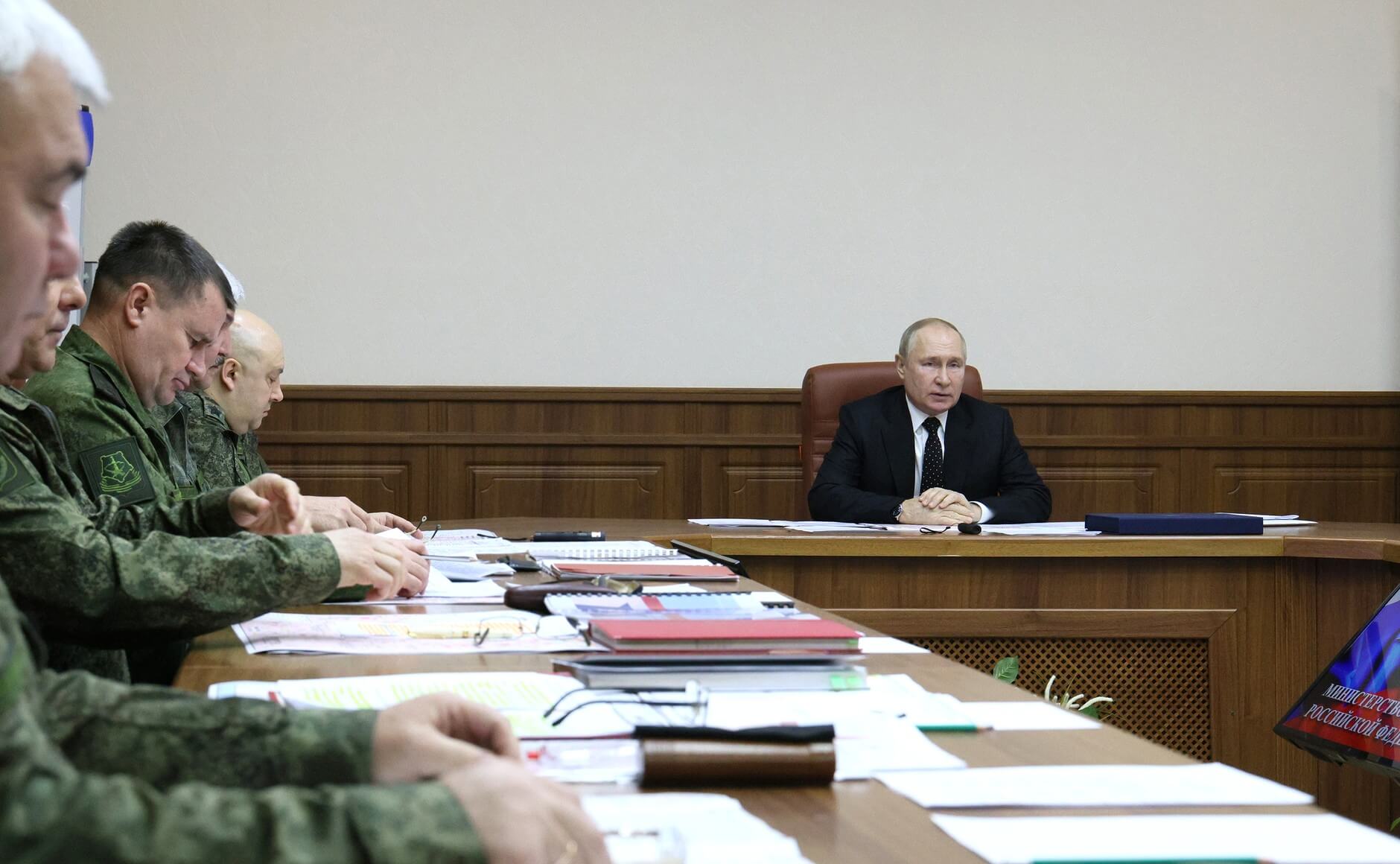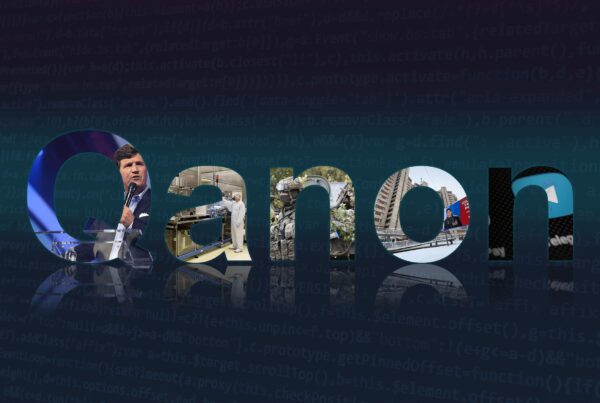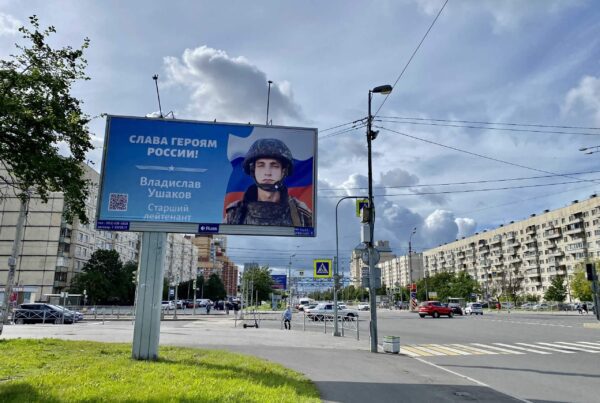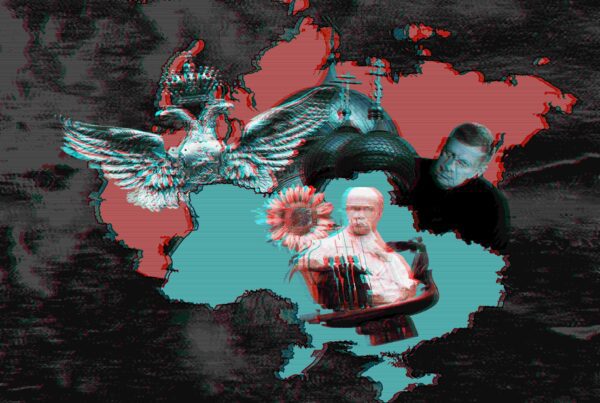Will President Vladimir Putin’s regime implode? Unfortunately, the media’s fixation with this question — understandable as it might be — has prevented us from gaining a more holistic understanding of how Russian politics are working right now.
While fully in the grips of a new form of bellicose, authoritarian rule, Russia has not fallen down the totalitarian path and rather exhibits signs of a skewed but dynamic authoritarian public politics. Putin’s regime is a personalist dictatorship in a partial state of exception, and one with a great deal of elite quiescence at the top. Yet the political dynamics playing out in the public eye are hardly uniform and reflect real claims to power and influence that can help Western observers understand Russia’s transforming political system.
Three interrelated expressions of public politics are particularly useful for understanding regime dynamics across Russia today. First is the vocal chorus of “war correspondents” who have become a source of creative criticism on the Russian political spectrum’s hawkish flank. Second is the rise of warlord-like political-military figures and their intentional use of politics as public spectacle — ever more notable when set against the studied submission of the regime’s broader elite cohort. Finally, there is the long-sidelined political party system which nevertheless manages to provide by far the clearest examples of divisions in lower-tier elite opinion on the war.
The Russian regime is in tremendous political and societal flux. These new developments provide insight into what Russia is becoming — a regime in which its legacy elite are quickly being outflanked and carefully challenged by a diverse set of ‘patriotic’ voices who are making open, public claims to political legitimacy and a place in the decision-influencing arena.
The Triumphs and Trials of the Voenkory Commentariat
The Russian domestic information space has constricted considerably, especially for previously surviving liberal and Western-leaning publications. Yet the opposite has occurred for Russian writers and commentators standing on the hawkish, pro-war, or nationalist side of the media divide. A rising cadre of “war correspondents” or voenkory (full: voennye korrespondenty) have been described as the “new opinion leaders” in the domestic media ecosystem. Some popular voenkory are anonymous or collective groups with Telegram accounts, while others are individuals who are now developing personal brands as embedded reporters. Although the term is properly specific to in-the-field writers and combatants, the environment they inhabit includes a wider set of discontented, pro-war commenters and opinion-shapers writing on the same or similar platforms.
The voenkory have become notable — both inside Russia and among observers in the West — for their open criticism of the Russian Armed Forces’ conduct in the war. This criticism is wide-ranging, using evocative and emotional language, and usually offers far more specificity about the operational, tactical, and even logistical details of the conflict than the mainstream Russian media or government press briefings provide.
The place of voenkory in the Russian media environment is now undeniable — and extraordinary. Their legitimacy as knowledgeable, Kremlin-skeptical, pro-war voices give them a useful cache and has allowed for a considerable audience to grow, a natural effect of well-informed and brand-aware internet media entrepreneurs bypassing traditional channels of authority and information. Even voenkory accounts that show signs of influence and manipulation by state and political elites have usually established themselves with critical commentary. Indeed, the government’s eagerness to coopt the voenkory is a marker of their rise. Putin has met multiple times with a select cadre of voenkory both privately and publicly and then formalized their role as an ersatz “fourth estate” through a working group set up this December.
As a result, voenkory have become influential in shaping the course of Russia’s wartime authoritarian politics. Following the battlefield disasters at Izyum-Balakliya, harsh voenkory criticism proved impossible to ignore and led to public recriminations among the military leadership over responsibility for the failure, ultimately paving the way for Gen. Surovikin’s appointment in October 2022.
Where this core of widely read wartime writers goes remains unclear. The fact that the Kremlin can only partially keep the lid on criticism coming from conservative and militant patriotic flanks is itself worth keeping close eyes on. Implicit trust in the military establishment, at least as far as strategic and operational decision-making goes, has plummeted among Russian policy commentators, and Moscow likely does not have the luxury of assuming that it can control the information space out of a sense of residual deference from the hawkish side.
The New Political Military Barons
The war correspondent phenomenon has influenced the course of Russian domestic politics, but they aren’t the only ones. Indeed, one of the key developments of the last year has been the steep rise in stature of individual elites taking on similarly entrepreneurial roles as politician-warlords. The two most important are Ramzan Kadyrov, the longtime subnational dictator of Chechnya, and Evgeny Prigozhin, the Putin-connected oligarch who runs the Wagner mercenary group.
Neither Kadyrov nor Prigozhin are new figures in the Russian elite scene. Kadyrov, of course, has had a particular cache as an inveterate antagonist with other members of the Russian security service ecosystem, consistently fighting with the Federal Security Service over lines of authority and degrees of impunity. Meanwhile, the Wagner group grandly made its name in Syria explicitly in the service of the regime’s foreign policy, and it has also furthered Russian geopolitical reach — especially across Africa — in recent years.
Even so, their statures have risen considerably since the war, a function of their curious position as personal commanders of significant military forces that operate semi-independently from the Russian Armed Forces. This unusual division in the Russian state’s military force structure is not a complete separation, but battalions of Kadyrovtsy have been used as distinct shock troops — and certainly framed that way for domestic media consumption — while Wagner has been granted informal allowances to recruit from prisons and otherwise bypass the cumbersome bureaucratic hurdles of the armed forces. And Wagner is very much so in the middle of the ongoing Battle of Soledar today, of course.
This unusual degree of freedom in the military sphere has facilitated both men’s public posturing. Kadyrov and Prigozhin make extensive use of Telegram, videos, and interviews to signal full loyalty to Putin while also burnishing their personal brands as pragmatic, dangerous leaders ready to use extraordinary violence. Yet this image-building goes well beyond crafting an enticing, martial profile. It has provided openings for both to intervene in Russian domestic politics with far greater force than before. Indeed, they have carved out niches for themselves as wartime “barons,” able to directly impact both politics and the course of the war.
For some months from February 2022 onward, Russian politics — in the sense of public disputes and negotiations among political elites — had largely gone quiet. Although some hold to a view that authoritarian regimes do not have displays of genuine elite disagreement, this has certainly never before been true in Russia. Yet it achieved the unusual condition of truly de facto “closed” authoritarianism briefly as the war began and Russian elites overwhelmingly rallied to the president. For a few months, the closest measurable element of dissensus was comparing elites that waxed poetic about the special military operation versus those that were quieter.
Kadyrov and Prigozhin have decisively ended this atmosphere of quiescence and in doing so have shown themselves distinct from many other Russian elites who would prefer to wait out the crisis in political submission and silence. Most prominently, Prigozhin has picked a fight with St. Petersburg Governor Aleksandr Beglov, raising dangerous accusations of insufficient loyalty while also seeking to revise the substantive distribution of rents in his favor. At the same time, officials such as Defense Minister Sergei Shoigu have seen their legitimacy and authority collapse in tatters, furthering the perception that informal actors carry greater influence with Putin.
The rise of political-military barons — that is, these political figures with personal control over real military resources and favored, clientelist connections to the apex executive — is an important change. Nothing like it has been seen since the 1990s. Analogies to feudal organization are often overplayed, but fit better than they should when thinking about how to conceptualize the relation between Putin and what seem to be armed, politically-active vassals.
Predicaments of Patriotic Party Politics
While much of the public politics of wartime Russia have been extraordinary and unusual, the dull drip of domestic party politics continues. Russia’s politics have often been seen as a façade or at best an occlusion of political realities. In fact, the so-called “systemic” parties were last truly relevant between 2012 and 2016, when loyalist parliamentarians actually pushed forward an illiberal legislative agenda with greater vehemence than the Kremlin expected — or wanted. Yet after a crackdown on politics that lasted from February through the early summer, Russia’s formal parties have once more emerged as an expression of divisions within the lesser elite.
The return of Russia’s parties suggests that the regime has not yet fundamentally lost the shape it had acquired by the end of the 2010s. Today, the parties act in two key ways. First, they function as petri dishes for incubating and developing new creative, illiberal legislation. Parliamentarians from the ruling party, United Russia, as well as from systemic opposition parties such as the patriotic-xenophobic Liberal Democratic Party of Russia, and Sergei Mironov’s social-democratic zombie party, A Just Russia-For Truth, have all competed to put forward legislation in keeping with the sharp anti-Westernism that forms the regime’s primary ideological orientation. As the regime seeks to double down on a revitalized ideological agenda, parliamentarians, uncertain of where they stand, seek new and more creative ways to signal their loyalty and usefulness. And the Duma’s organization does allow for ambitious politicians to show their mettle through innovative illiberal lawmaking if they are so inclined.
Second, the systemic opposition has sought to articulate a range of positions on the conduct and execution of the war. With support for the war mandatory from February onward, the opposition has offered variations on what is referred to as the “patriotic” stance. Consider the distinction between so-called “angry” or “wrathful” patriots (rasserzhenniye patrioty) and pure loyalists, which has played out especially openly within the nominally opposition Communist Party of the Russian Federation.
These “angry patriots” have been described in the Russian media as “figures quite loyal to the authorities, who, however, do not deny themselves the right to publicly ask uncomfortable questions about problems, mistakes or even failures during a special operation or, say, partial mobilization.” The connection between the voenkory and these “angry patriots” is clear. In fact, the term first referred to influential war correspondents such as Igor Strelkov. In the realm of party politics, however, it has a second meaning, describing those, particularly in the largest opposition party, who seek to avoid becoming fully absorbed by the country’s pro-war loyalism.
Yet this stance leaves the “angry patriots” susceptible to attacks from the committed loyalists. Prigozhin, in another example of his active participation in public political discourse, has denounced the “angry patriots” of the party system as “talkers” who need to step up and shoulder burdens if they are going to criticize.” The pure loyalist position — expressed both by the regime party and by the Communist Party leadership — is simply to agree with the government, the general staff, and the regime in general. Playing in the realm of criticism has dangers, and while the voenkory have unimpeachable records given their contacts in the field, the “angry patriots” walk on more unstable ground.
The fact that party politics remains detached from the core regime is a feature, not a flaw, of the current political order. It is likely that there will be see flare ups of carefully pitched dissent and innovative positioning over the course of 2023, and these should not be mistaken for evidence that the regime is about to fall. Major regional elections are scheduled for September, and the regime has backed away from canceling them altogether (although should war conditions worsen, everything will be in play).
Russian commentators in the domestic press and on popular Telegram channels have highlighted a variety of tactical opportunities for the upcoming year. Some hope to improve the Liberal Democratic Party’s brand to create a second, loyalist-nationalist political party for those who no longer trust the ruling party. Others expect the government to try to bury the Communist Party and its troublesome “angry patriots” for good. Finally, there’s always the chance that the regime will seek to give the system a full, dramatic overhaul, as political reporters had suggested in the year prior to the war.
This all leads to a domestic political picture that is more complicated than sometimes assumed. Russia has not gone the way of full, totalitarian mobilization or wholesale, forced political quiescence. Diverse, critical voices survive in a variety of formats. This is notable in the coopted party system, which nevertheless contains many ambitious, lower-tier figures who see an opportunity to use the war to advance their own careers. We will see how this shakes out as the year progresses.
Surveying the Public Politics of a Wartime Authoritarian Regime
The domestic political situation in Russia is unprecedented. The regime’s usual internal opponents have fled, and its standard allies have proven more critical than expected. The brief moment of near-total elite closure existed for only a few months into the war, and Russia’s failure to achieve its strategic and operational objectives means that the space for ambitious voices has risen precipitously in a matter of months.
Wartime Russian politics thus far has been characterized by a surprising degree of criticism from the hawkish flank, the development of political-military barons whose relations to the supreme ruler are qualitatively new, and the resilience of a subservient section of political elites who have continued to work creatively towards the regime’s illiberal goals while navigating what it means to be “patriotic” and loyal.
The result is somewhat reminiscent of the more pluralist interwar-era dictatorships or certain bureaucratic-authoritarian states of the mid-to-late 20th century. The small, “pro-Western” flank of the Russian political spectrum — mostly operationalized in political practice as either professional technocrats or the bourgeois “protest electorate” — has now been silenced or abruptly excised from the body politic. The regime no longer pretends to be anything other than explicitly, if amorphously, ideological, and internal incentives to lean into a pervasive sense of a beleaguered, “fortress Russia” have risen considerably. But there remains a large swathe of carefully varied positions within what amounts to a “wartime authoritarian” camp, whose factionalism is currently subdued at the top but far more dynamic among lesser elites and what counts for civil society.
Looking at Russian public politics in this manner has important implications for those concerned with the conduct of the Russo-Ukrainian War. For example, continued battlefield losses on the Russian side is sometimes interpreted as a trigger for regime collapse, but it may be better to understand such reverses as feeding into the dynamics suggested above – the further rise in the legitimacy of the voenkory as key points of pressure on the military leadership and political control of it.
Similarly, regardless of battlefield outcomes, experience in the war has furthered Prigozhin and Kadyrov’s substantive political power – and the development of battle-hardened cadres that are personally loyal and associated with particular heroics in the war will make it harder for these militant figures to be ignored by other players in Russian politics. It also may change how the military leadership chooses to use – or misuse – these forces as they have political as well as warfighting power.
And the background of the formal party system continuing on means that Russia will be subject to (authoritarian) electoral cycles, which may distract the regime and create electorally driven incentives for these actors to time major offensives. That is, Russian campaigns will have a background condition of a season of public political contestation coming up in September, as well as the future presidential election in 2024.
This is a republication of the original article which was published by War on the Rocks.
Photo: “Visit to joint staff of military branches involved in special military operation 05” by Kremlin.ru licensed under CC BY 4.0.







